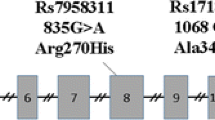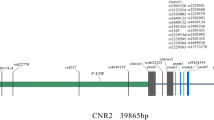Abstract
Summary
This study was designed to investigate the association of circadian gene single nucleotide polymorphisms (SNPs) with the risk of osteoporosis. We found that the rs3781638 GG genotype was positively associated with osteoporosis prevalence in females, whereas the rs2292910 AC genotype was negatively associated with osteoporosis prevalence in a geriatric cohort.
Introduction
Studies have shown that disruption of endogenous circadian rhythms may increase the risk of developing type II diabetes and obesity, which are reportedly associated with osteoporosis (OP). Thus, abnormalities of circadian genes may indirectly induce OP. Here, we investigated the association of OP with 14 SNPs located in seven circadian genes.
Methods
The research subjects, geriatric residents of Shanghai Minhang, China, diagnosed with OP (N = 171) or osteopenia (N = 226) or without specific diseases (N = 200), were genotyped for 14 genetic variants of circadian genes by competitive allele-specific polymerase chain reaction. The prevalence of polymorphisms among the subject groups and the association between the SNPs and osteoporosis were investigated.
Results
Among the 14 genotyped SNPs, we found an association between the CRY2 gene rs2292910 SNP and osteoporosis (r = −0.082, p = 0.045) in the geriatric cohort. We found a decreased risk between cryptochrome 2 rs2292910 and OP (A/C odds ratio = 0.647, p = 0.044) but an increased risk between MTNR1B rs3781638 and OP (G/G odds ratio = 2.058, p = 0.044).
Conclusion
For the first time, we show that Cry 2 rs2292910 and MTNR1B rs3781638 are associated with osteoporosis in a Chinese geriatric cohort. Therefore, targeting the abnormalities of the CRY2 and MTNR1B genes may be a potential strategy to treat and/or to prevent osteoporosis.

Similar content being viewed by others
References
Harvey NC, Matthews P, Collins R, Cooper C (2013) Osteoporosis epidemiology in UK Biobank: a unique opportunity for international researchers. Osteoporos Int 24:2903–2905
Clark GR, Duncan EL (2015) The genetics of osteoporosis. Br Med Bull 113:73–81
Wu FY, Liu CS, Liao LN et al (2014) Vitamin D receptor variability and physical activity are jointly associated with low handgrip strength and osteoporosis in community-dwelling elderly people in Taiwan: the Taichung Community Health Study for Elders (TCHS-E). Osteoporos Int 25:1917–1929
Luo L, Xia W, Nie M, Sun Y, Jiang Y, Zhao J, He S, Xu L (2014) Association of ESR1 and C6orf97 gene polymorphism with osteoporosis in postmenopausal women. Mol Biol Rep 41:3235–3243
Tural S, Alayli G, Kara N, Tander B, Bilgici A, Kuru O (2013) Association between osteoporosis and polymorphisms of the IL-10 and TGF-beta genes in Turkish postmenopausal women. Hum Immunol 74:1179–1183
Tural S, Kara N, Alayli G, Tomak L (2013) Association between osteoporosis and polymorphisms of the bone Gla protein, estrogen receptor 1, collagen 1-A1 and calcitonin receptor genes in Turkish postmenopausal women. Gene 515:167–172
Vieira E, Ruano EG, Figueroa ALC, Aranda G, Momblan D, Carmona F, Gomis R, Vidal J, Hanzu FA (2014) Altered clock gene expression in obese visceral adipose tissue is associated with metabolic syndrome. PLoS ONE 9(11), e111678
Medeiros R, Kelly MA, Rees SD et al (2012) Circadian gene variants and susceptibility to type 2 diabetes: a pilot study. PLoS ONE 7, e32670
Hoffman AE, Zheng T, Yi CH, Stevens RG, Ba Y, Zhang Y, Leaderer D, Holford T, Hansen J, Zhu Y (2010) The core circadian gene cryptochrome 2 influences breast cancer risk, possibly by mediating hormone signaling. Cancer Prev Res 3:539–548
Katsuya T, Sugimoto K, Hozawa A, Ohkubo T, Ohkubo T, Yamamoto K, Matsuo A, Ogihara T (2003) Genetic risk factors for cerebral infarction using data from a large scale genetic epidemiological study: the Ohasama study. Geriatr Gerontol Int 3(3):150–153
Marques FZ, Campain AE, Davern PJ, Yang YH, Head GA, Morris BJ (2011) Genes influencing circadian differences in blood pressure in hypertensive mice. PLoS ONE 6(4), e19203
Maronde E, Schilling AF, Seitz S, Schinke T, Schmutz I, van der Horst G, Amling M, Albrecht U (2010) The clock genes period 2 and cryptochrome 2 differentially balance bone formation. PLoS ONE 5:e11527–e11535
Lin F, Chen X, Li X, Zhao Q, Tan Z (2013) Over-expression of circadian clock gene Bmal1 affects proliferation and the canonical Wnt pathway in NIH-3T3 cells. Cell Biochem Funct 31(2):166–172
Kim H, Koh SY, Ku SH, Kim JH, Kim JG (2014) Association between polymorphisms in period genes and bone density in postmenopausal Korean women. Climacteric 17:605–612
Takarada T, Kodama A, Hotta S, Mieda M, Shimba S, Hinoi E, Yoneda Y (2012) Clock genes influence gene expression in growth plate and endochondral ossification in mice. J Biol Chem 287:36081
He Y, Lin F, Chen Y, Tan Z, Bai D, Zhao Q (2015) Overexpression of the circadian clock GeneRev-erbαAffects murine bone mesenchymal stem cell proliferation and osteogenesis. Stem Cells Dev 24:1194–1204
Loboda A, Kraft WK, Fine B et al (2009) Diurnal variation of the human adipose transcriptome and the link to metabolic disease. BMC Med Genet 2:7
Sherman H, Genzer Y, Cohen R, Chapnik N, Madar Z, Froy O (2012) Timed high-fat diet resets circadian metabolism and prevents obesity. FASEB J 26(8):3493–3502
Zheng C, Dalla Man C, Cobelli C, Groop L, Zhao H, Bale AE, Shaw M, Duran E, Pierpont B, Caprio S, Santoro N (2015) A common variant in the MTNR1B gene is associated with increased risk of impaired fasting glucose (IFG) in youth with obesity. Obesity 23(5):1022–1029
Been LF, Hatfield JL, Shankar A, Aston CE, Ralhan S, Wander GS, Mehra NK, Singh JR, Mulvihill JJ, Sanghera DK (2012) A low frequency variant within the GWAS locus of MTNR1B affects fasting glucose concentrations: genetic risk is modulated by obesity. Nutr Metab Cardiovasc Dis 22:944–951
Acknowledgments
The study was supported by the Biobank of the Fifth People’s Hospital of Shanghai, Fudan University, by a research grant from the Shanghai Fifth Hospital of Fudan University (2014WYYJ10), by the Scientific Research Project of Shanghai Municipal Health and Family Planning Commission (201540203), and by Grants from the Zhejiang Province Natural Science Foundation (Y 14C200042).
Author information
Authors and Affiliations
Corresponding authors
Ethics declarations
Conflicts of interest
None.
Electronic supplementary material
Below is the link to the electronic supplementary material.
Supplemental Table 1
(DOCX 17 kb)
Supplemental Table 2
(DOCX 19 kb)
Rights and permissions
About this article
Cite this article
Li, Y., Zhou, J., Wu, Y. et al. Association of osteoporosis with genetic variants of circadian genes in Chinese geriatrics. Osteoporos Int 27, 1485–1492 (2016). https://doi.org/10.1007/s00198-015-3391-8
Received:
Accepted:
Published:
Issue Date:
DOI: https://doi.org/10.1007/s00198-015-3391-8




